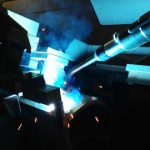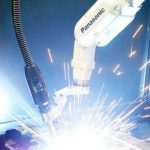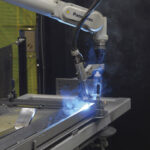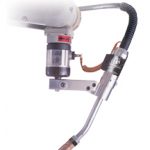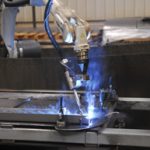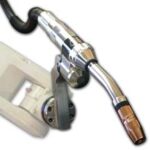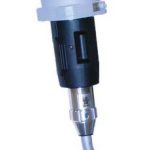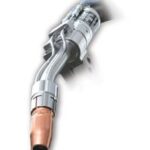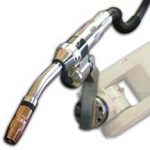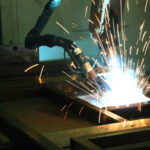Water-Cooled Robotic MIG Guns Can Reduce Consumable Costs and Downtime
For some fabricators, the choice between an air-cooled or a water-cooled robotic MIG welding gun is simple. Some heavy-duty applications simply demand a water-cooled model due to the high amperage and duty cycle requirements of the job — performance requirements that would cause an air-cooled gun to quickly overheat and fail.
However, there are other less conventional robotic welding applications that may benefit from using a water-cooled MIG gun, too, and can contribute to much lower consumable costs and greater productivity. Water-cooled MIG guns typically have higher duty cycles and amperages, meaning they can be run for longer periods of time without stopping. Cooler guns mean cooler front-end consumables. In particular, it is possible to greatly extend contact tip life with these guns compared to air-cooled models.

Deciding which system is the best choice involves careful analysis of several factors. In addition to amperage requirements and duty cycle, a fabricator should consider the up-front costs, potential return on investment (ROI) and the application specifics. Some fabricators may choose water-cooled robotic MIG guns based on the length of welds — the long arc-on time needed to produce these welds generates more heat in the gun. Similarly, critical start and stop points along a longer weld joint typically require a gun that can handle the extended amount of welding.
Considering the weld joint design and the material type and thickness, as well as joint access can also factor into whether to choose a water-cooled MIG gun. For example, aluminum or heavy plate sections that have been pre-heated can generate substantial radiant heat that affects the cooling of the gun and can adversely affect the life of the front-end consumables. A water-cooled gun can help here.
Some water-cooled robotic MIG guns have smaller diameter necks than air-cooled model due to optimized cooling capacity that requires less copper in the neck. As a result, they can reach into tighter spaces, through complex tooling restraints or into parts with access holes. When deciding whether a water-cooled robotic MIG gun is the best choice, it’s important to keep in mind that these products require more maintenance and often have a higher up-front cost. It is necessary to weigh those factors against the productivity gains and savings that can result from longer consumable life.
Understanding water-cooled MIG guns
Keeping MIG welding equipment cool is necessary to protect the power cable, gun body, neck and consumables from damage due to the radiant heat from the arc and the resistive heat from the electrical components in the welding circuit.
A traditional water-cooled robotic MIG gun circulates a coolant from a radiator unit through cooling hoses inside the power cable and into the gun body and neck. The coolant returns to the radiator where the radiator’s baffling system releases the heat absorbed by the coolant. There are guns available on the market today, however, that cool only the front of the gun where heat is generated and still use an air-cooled cable. These features help save costs and eliminate potential leaks from the cable bundle where excess movements from whipping and repetitive motion create the greatest wear.
These features contrast to a completely air-cooled MIG welding system, which relies solely on the ambient air and shielding gas to dissipate heat that builds up along the length of the welding circuit. Air-cooled systems use much thicker copper cables, and inner neck tubes; water-cooled robotic MIG guns use much less copper in the power cables and thinner wall sections in the necks because the cooling solution carries away the resistive heat before it builds up.
In general, water-cooled robotic MIG guns are beneficial for high-amperage applications and are typically available in 300 to 600 amp models. Closely related to amperage is duty cycle, which refers to the amount of time during a 10-minute cycle that the gun can operate at its rated capacity without overheating. Water-cooled robotic MIG guns can have varying duty cycle capacity depending on the manufacturer and model.
The amperage requirements, the length of time the arc is actually operating, and how the system will deal with the heat of welding in a specific application are among the most important considerations when choosing a water-cooled robotic MIG gun.
Selecting a water-cooled robotic MIG gun
When choosing a water-cooled robotic MIG gun, be sure to select a product and consumables that use high quality materials that can handle high heat.
Guns on the market come in two styles: conventional and through-arm versions.Through-arm robotic MIG guns carry the cable assembly through the arm of the robot. This style can offer greater protection since the arm of the robot shields the power cable from abrasive wear and minimizes cable whipping during air moves. It’s important to know if the robotic arm is a conventional or through-arm style, so the gun and associated mounting bracket can be chosen to match. Knowing the robot model is also important for proper mounting hardware and insulating of the gun from the robot wrist.
As with air-cooled applications, make sure during installation that the selected water-cooled robotic MIG gun allows proper joint access. Having a neck design with the proper geometry that accesses the joint with the appropriate travel and work angles can prevent poor weld quality and/or the need to re-tool expensive fixtures, which could add downtime.
To make sure the cable bundle is the correct length, it’s also critical to know where the wire feeder will be located on the robot. If a cable bundle is too short, it might stretch; if it’s too long, it could interfere with opposing structures and also fail prematurely due to excess flexing.
Some water-cooled robotic MIG guns on the market have features that make them especially easy to use and to integrate into the robotic welding system. One available feature is the quarter-turn connection, which helps establish a quick and tight connection to help maintain good conductivity and prevent shielding gas leaks. Models with the quarter-turn connection feature are designed to seat the connection properly once a quarter turn is made, making it much easier and faster to change the neck.
Water-cooled robotic MIG guns with this quarter-turn connection feature also offer an automatic shutoff valve, to shut off the water flow any time the neck is changed, which helps simplify routine maintenance. Consider adding a flow switch to a system with water-cooled robotic MIG gun. These switches ensure water is flowing through the system; if the system doesn’t detect the flow of water in the gun, it will shut down and give an error message. Operating a gun without water flow will very quickly cause a catastrophic failure. All of this means added downtime and costly repairs.
Maintenance and usage tips
Water-cooled robotic MIG guns do require more maintenance than air-cooled models, since the presence of the water circuit introduces more potential issues. For example, if a hose or the neck is leaking, coolant could drip into the molten weld pool, leading to porosity and costly rework. It’s a good idea to conduct preventive maintenance each day or before the start of each shift. Just as with any welding system, it’s important to inspect a water-cooled robotic MIG gun to ensure that all consumables and connections are tight and working properly. Inspect the water lines frequently to make sure they are tight and have no leaks, and replace the O-rings when necessary (e.g., when cracks or wear appears).
Using an automatic reamer or nozzle cleaning station adds significant benefits to the preventive maintenance of water-cooled robotic MIG guns. A reamer eliminates the need to manually clean out the front-end consumables and can, with the addition of an automated sprayer, add anti-spatter compound to help extend consumable life further. This feature adds to the overall cost of the equipment, but helps increase uptime for production, with less manual intervention, and offers a solid return on investment in most robotic welding operations.
Do not fall prey to the notion that it is cheaper to use tap water in a water-cooled gun, as it can cause algae growth or mineral build-up and eventually clogging. Instead, use deionized water or the specially treated coolant solution recommended by the manufacturer. These coolants contain special additives to lubricate internal pumps and O-rings, as well as to prevent algae growth.
Consider the return on investment
Choosing a water-cooled robotic MIG gun is often a necessity because of the demands of the application. A water-cooled model requires more up-front investment and more maintenance, but it can provide significantly longer consumable life and increased productivity from fewer consumable changeovers. Consider the various costs, specific application needs and accessibility to decide if a water-cooled robotic MIG gun offers a good option for a specific robotic application. Often a welding distributor, welding equipment manufacturer or robotic welding system integrator can help.
Trends Associated with Robotic Welding Guns
Trends Associated with Robotic Welding Guns
Manufacturing and fabrication environments are dynamic, ever changing with the economy, customer demands, available labor and skill sets, and competitive forces, among other factors. To maintain a favorable position in the industry, it is critical for companies to continually look for ways to increase efficiencies while also improving quality and decreasing costs. For many, that means a shift toward welding automation, which has experienced its own changes in the last 10 years.
During this time, robotic welding manufacturers have transitioned away from the manufacture of conventional robotic welding systems to the development of through-arm styles, in which the power cable of the robotic MIG gun runs through the arm of the robot as opposed to over top of it. These are now the prevalent robot styles in the industry and this change has had a direct impact on the design of the robotic MIG guns for the marketplace. But it is not the only trend associated with robotic MIG guns. Like any component of the welding operation, this equipment has continued to evolve to the demands of the industry and to provide solutions to improve the business of welding.
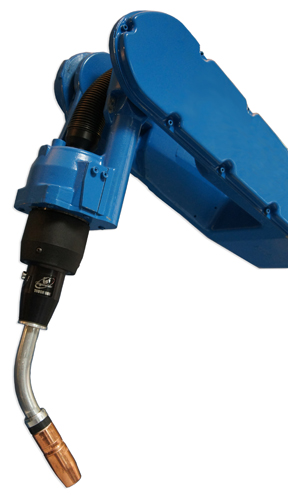
The through-arm benefits
Improving and simplifying cable management has been the driving force behind the shift toward through-arm robots and, therefore, the development of through-arm robotic MIG guns to accompany them. With conventional style robots and guns, the cable is prone to “whipping” during air movements, which causes undue stress on this portion of the gun, and can lead to premature wear and failure caused by the cable rubbing against the robot or tooling. It also creates additional cost and time for companies to implement cable management systems.
The through-arm style robot and through-arm robotic MIG gun make it easier for companies to minimize downtime associated with cable management and reduce costs for cable replacement. It also eliminates the risk of selecting the wrong cable length, a common mistake that occurs with conventional robotic MIG guns. The through-arm robot model dictates the length of the robotic MIG gun cable, so there is no concern about it being too long (which requires extra cable management or could cause wire feeding issues) or being too short (which can cause the cable to stretch and fail prematurely) — both issues associated with conventional robotic MIG guns.
There are other benefits to the shift to through-arm robots and through-arm robotic MIG guns, namely that they can accommodate for increases in welding speed that are also becoming customary in the industry. Robots are getting much faster, but with the through-arm robot there is no longer the concern of the robotic MIG gun cable getting caught on tooling during quick movements.
Too, it is easier to complete offline robot programming or welding simulation and have it work with these robots because there is less concern about having to accommodate for clearance for the power cable in an application. If a robotic MIG gun fitted for a through-arm robot works in simulation, it will most likely work in the real-world application.
Increased cable durability, simplified replacement
As companies strive for greater arc-on time and higher productivity, robotic MIG gun manufacturers are helping by providing increasingly more durable power cables on this equipment and implementing features that simplify cable changeover. Some manufacturers offer a rotating power connection on the front of the cable that allows the robot to spin on its final axis as much as necessary without binding the cable. This feature helps minimize stress due to routine torsion and to extend the life of this part of the gun, as well as to increase the robot’s operating range by allowing it to rotate a full 720 degrees (360 degrees in both directions) and weld faster.
Built-in quick-change features on many robotic MIG guns also expedite cable replacement, adding to the operation’s productivity, while the use of stronger cable materials help better resist wear and UV damage from the arc for longer component life.
Utilizing solid mounts
Another trend associated with robotic MIG guns is the use of solid mounts (also called solid arm mounts) as opposed to the clutch mounts that were used previously to protect the gun in the event of a collision — an occurrence commonly caused by an incorrectly position work piece or tooling that has been left out of position, among other factors. This trend is due to more sophisticated collision detection software being built into today’s robots. This software is increasingly capable of monitoring current rates and/or torque so it can quickly stop the robot when an impact occurs. Solid mounts are made from durable, high-strength aluminum alloys, and are an alternative to the clutches used with older robot models.
There are two key benefits to using a solid mount for robotic MIG guns compared to a clutch:
- They offer greater repeatability for higher weld quality
- They are less expensive.
Clutches (also called shock sensors) are designed to recognize the physical impact of the robotic MIG gun on a solid surface during a collision and send an electrical signal back to the robot controller, causing the system to stop. While effective, clutches are designed to move, which can affect tool center point (TCP) after a collision. Also, since it is an electrical device, it costs more than a solid mount and is more prone to failure because of its internal components — expenses that many companies can now happily omit.
Creating more space, better joint access
As companies seek ways to become more competitive and produce higher volumes of parts, they need to maximize floor space to make room for more robots to do the job. As a result, robots and welding cells are becoming smaller and in many instances, tooling has become more complex. These changes pose greater space constraints when it comes to the robotic MIG gun.
Many robotic MIG gun manufacturers have responded to this trend by creating guns that provide a more open work envelope around the mounting arm (the depth from the wrist of the robot to the tip of the robotic MIG gun) so maneuvering around tooling and gaining joint access becomes less cumbersome.
There are also more options for neck lengths and angles available for robotic MIG guns, which helps companies gain access to complicated joints.
More cooling options
Because many robotic welding applications tend toward higher amperages and longer arc-on times, it is critical for companies to have a robotic MIG gun that provides adequate amperage without overheating. The complexity and increased cost of water-cooled robotic MIG gun systems (compared to air-cooled models), however, make some companies wary of the investment for their high amperage applications. Too, if there is an issue with the coolant flow, there is the risk of the robotic MIG gun overheating and failing — an event that can be costly not just for replacement of the gun, but also potentially for rework of the part should quality problems occur.
A development in recent years that addresses this concern is a hybrid robotic MIG gun. This type of gun has a durable neck like an air-cooled model and water lines that run external to the neck down to the nozzle. Should the coolant flow fail, the gun can rely on the underlying air-cooled unicable to provide enough current-carrying capacity for the job for a period of time, saving downtime and costs to address a complete robotic MIG gun failure. These guns also offer the higher amperage associated with a standard water-cooled gun, making them a good option for companies who need greater cooling capacity for an application.
Adding the extras
Because time is at a premium when it comes to robotic welding, companies are always looking for ways to extend their robotic welding cycle time — down to the second. To help maintain greater arc-on time while still protecting the robotic MIG gun and consumables from spatter build-up that could affect weld quality, adding air blast to robotic MIG guns is becoming a popular choice with some companies. This optional feature can be added to the robotic MIG gun and functions by blowing compressed air through the gun at a high pressure (approximately 100 pounds per square inch — psi) to clear debris loose in the front end while the robot is moving out of the way so the table/fixture can index. This addition can help companies reduce the number of times that the robotic MIG gun needs to be reamed out by a reamer or nozzle cleaning station, resulting in more arc-on time and greater productivity.
More to come
While robotic MIG guns may seem like a small part of the whole automated system, their design and functionality can have a significant impact on the cost, productivity and quality of an application. The trends discussed here are just some of the ways that robotic MIG gun manufacturers have adjusted the designs and capacity of the products to help companies gain the best results in recent years. As with any piece of welding equipment, robotic MIG guns will need to continue evolving just like any equipment in order to meet companies’ changing needs and to meet the demands of the fabrication and manufacturing industry.
Consider some of the top things to know about robotic MIG guns as a way to get the most out of this equipment. When it comes to robotic welding, precision, repeatability and speed are essential to ensuring a successful outcome in the operation. In order to gain the best benefits, companies rely on the robot’s ability to execute the same weld, exactly the same way and as fast as possible. And while the robot itself, proper programming and oversight by a trained welding supervisor are all important components in the robotic welding operation, the robotic MIG gun also has a direct impact on quality and productivity, as well as costs.
The cost to implement welding automation can be substantial, requiring companies to plan out the purchase carefully and to justify the expenditure to the appropriate financial or management personnel. The payback on the investment, however, can be equally beneficial. From productivity increases to quality improvements and cost savings, companies can often position themselves for greater competitiveness in the marketplace by adding robotic welding systems to their welding operation or by replacing manual welding cells altogether. Unlike companies that employ semi-automatic welding, those with robotic welding systems have the added responsibility of protecting the large capital investment in the equipment. But no two robotic welding systems are the same and likewise, there is no single step to ensure a successful outcome. Rather, a combination of the appropriate planning, equipment purchases and personnel training — among many other things — provides the best results. Paying close attention to the daily occurrences in a robotic welding cell and engaging regularly in some of the best practices discussed here can also help provide high quality results. Companies typically invest in welding automation to expedite the welding process, gain more consistent weld quality and/or to reduce costs. The process can also set companies apart from the competition by allowing for faster completion and delivery of products. For companies with high-volume demands and low-variation parts, robotic welding can become an important part of their production plans. Smaller companies with lower-volume, high-variety parts can also benefit, but they may require more flexible tooling and more programming time to accommodate for several types of products. The important consideration for both high- and low-volume production is to ensure that the parts to be welded lend themselves appropriately to an automated welding process. Robotic welding systems rely on consistent parts to provide consistent results. Companies that have or are planning to implement a robotic welding system need to be certain that parts are simple and repeatable. The presence of gaps, poor fit-up or poor joint access can have a detrimental impact on the high quality sought with robotic welding systems. Similar to a semi-automatic welding application, consistent workflow is also important for a successful robotic welding operation, with the main difference being the speed at which parts are delivered and welded since a robotic system is so much faster. The parts need to enter and leave the cell at a quicker and steadier rate — without bottlenecks — to gain optimal throughput. Companies should assess each activity leading up to the part entering the cell, making sure that the supply of parts matches the robot’s cycle time, and also assess the steps for handling the part after it leaves. In some cases, it may be necessary to change how the parts are fabricated upstream and completed downstream (e.g., finishing, painting, etc.) to establish good workflow. Companies should also look to eliminate non-value added activities, including excessive lifting or handling of parts, and avoid multiple trips to stack products or other similar activities. Robotic welding systems typically operate at higher amperages and longer duty cycles than semi-automatic welding operations — the robots can withstand the greater arc-on time and heat compared to a human operator. While those increases are excellent for supporting high productivity, the additional heat and welding duration can be especially harsh on consumables — nozzles, contact tips and gas diffusers (or retaining heads). Companies need to take steps to avoid the pitfall of excessive consumable changeover. Entering the weld cell for purposes other than part changeover or routine pauses in the operation can add unnecessarily to downtime, which can easily add up per shift, day, month and year, resulting in lost productivity. Excessive consumable changeover is also costly, as it increases inventory and inventory management. There are two key steps companies can take steps to increase consumable life in their robotic applications and reduce downtime. One, install consumables properly and maintain tight connections throughout the course of welding. Loose connections increase electrical resistance, causing the consumables to generate additional heat that can shorten their lifespan and/or cause them to perform poorly. Follow the manufacturer’s instructions for proper consumable installation, taking care to tighten the consumables appropriately. It’s also a good idea to check the consumables periodically during routine pauses in welding, as they can loosen throughout a shift. Two, install the robotic MIG gun liner properly, as this helps prevent downtime to address wire feeding issues or to correct a burnback, in which the wire “burns back” into the contact tip. Follow the manufacturer’s instructions for trimming and installation, using a liner gauge to confirm the correct liner length. Preventing premature power cable failure, which can occur in both through-arm robotic welding systems (where the cable feeds through the arm of the robot) or in standard robotic welding systems (also referred to as over-the-arm) is also important. Be mindful of the path the robot has been programmed to follow, the speed at which it moves and the cable length. The power cable should clear the robotic arm and tooling to prevent it from catching or rubbing against either part. Also, the robot should be programmed not to move too fast or abruptly. Aggressive movements can cause the power cable to snap. Make sure that the cable is the appropriate length — too short of a cable can stretch beyond its capacity during routine robotic movements, leading to greater wear. If the power cable is too long, it may be prone to kinking or becoming pinched by the robot’s arm. Preventive maintenance (PM) programs are among the most effective best practices a company can instill for a robotic welding system. Ideally, PM programs should cover every aspect of the system — from the robot to the contact tip. Proper PM activities can help prevent unscheduled downtime, low quality parts, costly repairs and/or equipment replacements. Companies will need to assess their PM needs on an individual basis and engage a maintenance team or other personnel to carry out the activities at the appropriate times and intervals. As a general rule, companies that weld thick materials or have applications with long, continuous welds common in welding automation can benefit from more frequent PM activities, as the rework for quality issues can generate much more costly rework compared to an application producing multiple smaller parts. Several PM activities can occur during routine pauses in production, including: • Cleaning the robot and fixturing to prevent the buildup of dirt, debris or anti-spatter compound, which could affect part fit-up. Other activities that happen less frequently like greasing the robots joints can be completed during a longer scheduled stop. Peripherals are often an overlooked part of the robotic welding system. The added cost of this equipment, which includes nozzle cleaning stations (also called reamers or spatter cleaners), is frequently considered an unnecessary expense. In reality, this equipment can maximize robotic welding performance and help companies gain a better return on investment (ROI) from their robotic welding system. As its name suggests, a nozzle cleaning station cleans the nozzle of dirt, debris and spatter, typically during routine pauses in the robotic welding operation. The goal of this cleaning action is to help ensure consistent shielding gas coverage, and with it, reduce weld defects, expensive rework and lost productivity. A nozzle cleaning station also helps extend the life of consumables, minimizing the downtime and expense for changeover. For the best results, the nozzle cleaning station should be mounted in close proximity to the robot to reduce the amount of time necessary for its arm to reach it. Companies can mount the peripheral overhead if need be. The robot should be programmed to clamp onto the nozzle cleaning station at a taught position exactly perpendicular to the cutting blade that clears out the spatter or other debris. Any misalignment to the position of the nozzle could lead to partial cleaning of the nozzle and excessive spatter build-up. Program the robot to go to the nozzle cleaning station as often as possible; the cleaner the consumables are, generally the better performing and longer lasting they will be. For companies who choose to attach an anti-spatter sprayer, it’s important to locate the spray in the appropriate position so it completely coats the inside of the nozzle. Ideally the outside should be covered to within three-quarters of an inch from the bottom of the nozzle. Other peripherals that companies can integrate into their robotic welding system include a wire cutter and a neck inspection tool (discussed in the next section). A wire cutter cuts the welding wire to a specified length, removing any inconsistencies at the end, providing for more reliable and smoother arc starts and better seam tracking for robots featuring that technology. For companies using touch sensing software, using a wire cutter in conjunction with a robotic MIG gun featuring a wire brake can help prevent problems with seam tracking. Touch sensing allows the robot to store position data and send electrical impulses back to the controller once it has located the joint. For applications that have slight variations in parts, touch sensing helps maintain weld consistency. It is also more cost-effective than investing in new tooling and fixturing to hold a part in a precise location; if the part moves slightly, the robot can still locate the joint and weld accurately, as long as the joint has well-defined edges. Using a wire cutter can ensure the wire is cut to a consistent length; the wire brake holds the wire in a set position as the robot articulates and searches for the weld joint, ensuring more accurate touch sensing readings for more consistent weld quality. For a robot to be repeatable and provide consistent welds, it is important for the system to maintain its tool center point or TCP, which is the focal point of the robotic MIG gun and its relationship with the position of the welding wire in the joint (gun-to-work distance). Typically, but not always, TCP issues occur after a collision, during which the neck of the robotic MIG gun becomes bent. To rectify the issue, welding operators can employ a peripheral called a neck inspection tool (or neck-checking tool) to bend the neck back to the proper angle. Most neck inspection tools are designed to accommodate standard necks for a particular brand of robotic gun. To use this peripheral, the welding operator or maintenance personnel needs to determine the tolerances for the robotic welding program and adjust the bent neck to meet the correct specifications. To maintain TCP, it is also important to install the robotic MIG gun neck properly, making sure it is fully seated. If not, it will extend too far and can cause TCP to be compromised. Programming the robot for a TCP check to verify proper position can also help prevent against quality issues and potential downtime. Another best practice to help ensure on-location welds is to check that fixturing is in the correct place, that it doesn’t allow the parts to move and that the base of the robot is securely in place. Periodically check that part variation hasn’t changed, as well. Designing parts for automation, managing workflow, selecting the right equipment and implementing a consistent PM program mean nothing if companies don’t have the right personnel in place to work with and/or oversee the robotic welding system. Investing in the people who are responsible for interacting with the robotic welding system should always be a priority. Skilled welding operators or employees with previous robotic welding experience are often a good choice for overseeing a robotic welding system. The personnel should undergo the proper up-front training before taking on the responsibility of working with the robotic welding system — loading and unloading parts and programming the robot for instance. Robotic welding integrators and robot manufacturers can often provide OEM-based training and continuing education. The goal is to instill the skills necessary not only to work with the robot on a daily basis, but also to be able to hone troubleshooting skills that can promote the maximum uptime in the robotic welding cell. These individuals can also be part of the PM programs mentioned earlier. As with any capital investment, companies need to take the appropriate steps to protect their robotic welding system. Whether it’s the addition of peripherals or implementing additional training, engaging in a few best practices can help companies gain a solid payback on the equipment, empower employees to be part of the company’s success and establish the robotic welding system as a profitable part of their business. The items discussed here are by no means exhaustive. Companies can seek out ideas for improving their operation from other, non-competitive companies, or work with a trusted welding distributor or robotic integrator for further options.
Choosing the proper robotic MIG gun is essential for optimizing welding automation, and it can help ensure good weld quality and reduce costs. Gun amperage, duty cycle and cooling capacity all matter. Too, proper installation and maintenance is key. The appropriate feeder placement, the right cable length and proper cable management tools can all drastically reduce downtime and costs for interrupting production for repairs. Here are three MIG gun options to consider. These guns rely on the ambient air to cool them, typically operate in the range of 300-500 amps at about 60 percent duty cycle with mixed gases. They are ideal for welding thinner materials and work best for shorter welds on high volume applications, such as in the automotive or recreation equipment industries. Advantages to air-cooled guns include durability and parts that are easier to maintain and less expensive to replace. They tend to have a more streamlined design and smaller working envelope, allowing greater access to smaller joint configurations. They also maintain accuracy well, which is good for consistent, repeatable welds. Air-cooled guns do have lower duty cycles compared to water-cooled guns, and they are not capable of welding continuously for as long. These guns offer the advantage of welding at higher amperages for prolonged periods. They generally have capacity of 300 to 600 amps, and are capable of a 60 to 100 percent duty cycle. Designed for welding on thicker materials, they are a good choice for applications in heavy equipment manufacturing or similar industries. Generally, the larger the weldment, the greater the chances it requires a water-cooled gun. The circulators or chillers used to prevent overheating in water-cooled guns do tend to add to overall cost and maintenance, and the parts can be expensive and time consuming to replace if they are damaged. Also, water-cooled cables have about one-fourth the copper found in air-cooled unicables, meaning water-cooled guns quickly fail if the water supply is interrupted. A third option is a hybrid air-cooled/water-cooled gun. This is useful for applications pushing the duty cycle limits of an air-cooled model, but that don’t require a complete water-cooled solution. These guns have a durable neck and unicable like an air-cooled model and offer the higher cooling capacity of a water-cooled front end. The hybrid guns, which can provide easier maintenance than water-cooled only, typically offer 300 to 550 amperage capacity at 60 percent duty cycle. Optimizing the performance of a robotic MIG gun can help improve weld quality and reduce downtime in the welding operation, resulting in cost savings for many companies. Two optional technologies that can assist with that performance enhancement — but that may not be well-known in the welding industry — are wire brake and air blast features. Both are available as factory-installed options or they can be retrofitted in a robotic MIG gun. The wire brake feature allows welding operators to better control the start and stop of the wire feed, which can improve quality. It can also lower costs by reducing wire usage. The air blast feature helps eliminate debris in the front part of the robotic MIG gun, reducing the chance for weld contamination, which can lead to rework. Many robotic welding systems weld continuously for two or three minutes, stop for a certain amount of time to move or change position, and then weld again for a programmed amount of time. The wire brake feature automatically stops the wire from feeding through the gun when the welding stops. This feature allows for consistent wire stickout after each stoppage in preparation for the start of the next weld. This feature also helps reduce the amount of wire used, since it prevents unspooling inside the gun with each stop and start. Additionally, the wire brake can help improve weld quality because it keeps the wire feeding at a steady rate, with a consistent stickout. For robotic applications that use touch sensing, a wire brake is an important option that supports good weld quality and productivity by helping to accurately determine the location of weld joints. Touch sensing is a software system that uses the welding wire to help locate the joint in a robotic welding application. The software allows the robot to store position data and send electrical impulses back to the controller once it has located the joint. For applications that have slight variations in parts, touch sensing helps maintain weld consistency. The wire brake holds the welding wire in a set position while the robot moves and searches for the weld joint. This action helps to ensure more readings and helps maintain consistent wire stickout. Because of the consistency and accuracy it helps provide, the wire brake feature is a good option for the most demanding robotic welding applications, including the thick-plate welding common in heavy equipment manufacturing. One thing to keep in mind when retrofitting a wire brake into a robotic MIG system is that the cable housing is slightly different than a standard cable, since it has a feature to allow for the wire brake option in the front housing. Also, when the gun has a wire brake the liner must be loaded from the back, even if it is a front-loading style of liner; there needs to be a jump liner inside the neck at the front to ensure steady feed of the wire into the liner. The lack of a small jump liner can lead to wire feeding problems and loose wire inside the cable. Another option to help maximize weld quality with air-cooled robotic MIG guns is the air blast feature, which — as the name suggests — blows high-pressure air through the front of the torch to remove debris. Air blast is exclusive to air-cooled models and cannot be used on water-cooled robotic MIG guns. This feature helps remove debris and contamination from the gun, which can potentially cause poor weld quality and eventual rework. The air blast feature is easy to install and can be programmed to operate between weld cycles. There are no extra maintenance issues to remember when using the air blast feature. The wire brake and air blast features are two options that can be used together or separately to help improve quality and performance in robotic MIG gun applications, leading to cost savings for welding operations. For assistance with these features, contact a trusted welding distributor or robotic MIG gun manufacturer.
Companies invest in welding automation to increase productivity, improve quality and reduce costs. Any unnecessary downtime can quickly interfere with obtaining those goals. But what about small amounts of scheduled downtime for maintenance. In most cases, a well-planned, efficient preventive maintenance (PM) program can yield positive results. Not only does it help ensure reliable throughput, but a properly executed PM program can also lower labor costs, reduce waste and minimize rework. It may even expedite the return on investment (ROI) in the automated welding system. Caring properly for the whole of an automated welding system is imperative, of course, but so too is maintaining the robotic MIG gun. In fact, the robotic MIG gun and its consumables are frequently overlooked components in the system. They are also relatively easy to maintain, and doing so can positively contribute to the efficiency of the entire welding operation. All companies, regardless of their size or arc count, can benefit from regular maintenance of their robotic MIG guns and consumables. The scope of the PM program, however, will vary according to each company’s application. For example, a company with higher-risk applications — those with large, thick parts; long cycle times and/or expensive rework — generally require more frequent care of the equipment than companies that weld smaller, less expensive parts. They simply stand to lose more (in both downtime and money) should something go wrong in the welding process. Most of the maintenance on a robotic MIG gun can be completed shift-by-shift with minimal off-line time. Welding engineers, welding supervisors, tool and die employees or members of the maintenance staff are all viable candidates to oversee the process. All personnel involved, however, need to be properly trained to identify potential problems in the weld cell and learn how to prevent them. They should also be aware that “in-process” maintenance does not constitute the whole of a PM program. Some activities may need to take place off-shift due to their complexity and the time needed to complete them. There are several key components to a good PM program for robotic MIG guns. Before starting any task, it is important to have the correct tools for the job. For example, be sure to have the proper adjustable or crescent wrench for changing diffusers or retaining heads, as well as the recommended pliers, welpers or tip installation tools for installing contact tips. Keep a sharp pair of side cutters on hand, too, to trim the robotic MIG gun liner. These tools help prevent burrs on the liner that can wear or drag on the welding wire. After establishing that the proper tools are in place to support the PM program, consider the following practices. During pauses in production — when the robot finishes welding a part or during routine contact tip changeover, for example — check for clean, secure connections between the MIG gun neck, the diffuser or retaining heads and the contact tip. Also, check that the nozzle is secure and any seals around it are in good condition. Having tight connections from the neck through the contact tip helps ensure a solid electrical flow throughout the components and minimizes heat build-up that could cause premature failure, poor arc stability, quality issues and/or rework. It also reduces the opportunity for burnbacks, which can lead to unplanned downtime for changeover. Look for changes in consumable colors, too, as those are a good indication that they are loose and require tightening. Spatter build-up can cause excessive heat in the consumables and MIG guns, block shielding gas flow, and increase costs for inventory and downtime to change over nozzles, diffusers and contact tips. Visually inspect consumables on a regular basis for signs of spatter, replacing them as needed. Also, consider adding a nozzle cleaning station (also called a reamer or spatter cleaner) to the weld cell. Like its name implies, a nozzle cleaning station removes spatter (and other debris) that builds up in the nozzle and diffuser. Using this equipment in conjunction with a sprayer that applies an anti-spatter compound can further protect against spatter accumulation. Track how long it takes for the liner in the robotic MIG gun to become worn or fouled, and schedule a replacement as needed. Replacing the liner prior to a failure prevents unplanned downtime to remedy wire feeding or quality problems later. Also, always cut the liner according to the manufacturer’s recommendation to prevent kinking and poor wire feeding that can lead to premature contact tip failure and/or arc instability. Periodically, release the drive rolls and check the force required to pull the welding wire from the feeder through the robotic MIG gun. Excessive drag indicates that there is a build-up of debris in the liner and it needs to be replaced. It is best to perform this task in between shifts, as opposed to during contact tip changeover, as it tends to take more time. Check regularly that the welding cable leads are properly secured and assess the condition of the welding cable on the robotic MIG gun. Look for signs of wear and be certain that the cable is not rubbing against any part of the robot’s metal casting, as that friction can cause the cable to loosen or become damaged. A worn spot on the robot (e.g., the absence of paint) or on the tooling is a good indication that the cable is rubbing against it. Rectifying the situation will likely involve repositioning the tooling or a cable management device and may need to occur while the robot is off-line. Still, a quick in-process inspection that identifies the issue can flag it for a later, proactive solution. Preventive maintenance programs don’t have to be complicated — only effective. Most of the robotic MIG gun maintenance discussed here can be completed on a shift-by-shift basis with minimal interference to cycle times and with minimal labor costs. The scope and frequency of a PM program will vary from company to company, of course, but carefully executed maintenance activities can help companies better realize the potential of their automated welding operation. And it can reduce costs by preventing problems, instead of being forced to resolve them.
Investing in welding automation can be a relatively quick way for companies to achieve greater productivity, improve weld quality and reduce costs. But protecting that investment is key to maintaining these benefits over the long term. Preventive maintenance (PM) programs are an easy and cost-effective way to help. These programs not only protect against costly downtime, but they can also help lower labor costs, reduce waste and minimize rework. In some cases, they may even expedite the return on investment (ROI) in the automated welding system. PM programs, however, shouldn’t be limited to just the robot or the power source. Protecting your robotic MIG gun and consumables with a PM program is also critical. It can help minimize weld defects, reduce downtime for changeover, and keep the robot up and running longer. Consider these tips to help along the way. There are four key tasks to consider as part of the PM program for your robotic MIG gun and consumables. 1. Check connections on a regular basis. During routine pauses in production, look for secure connections along the length of the robotic MIG gun. Be certain that the MIG gun neck, retaining head (diffuser), contact tip and nozzle are all tight and clean. Also check that the seals around the nozzle are in good condition. Good connections help ensure smooth electrical flow and minimize heat build-up that could lead to poor welding performance and/or premature consumable failure. 2. Regularly inspect the welding cable and power pin. Look for signs of wear on the welding cable and make sure that you have properly secured welding cable leads. Also make sure that the welding cable isn’t rubbing against any part of the robot’s metal casting, as friction can cause the cable to loosen or become damaged. Inspect the power pin, as well, to make sure it is secure. 3. Look for spatter build-up. Regularly inspect the nozzle, contact tip and retaining head for spatter build-up and replace these consumables as necessary. Spatter build-up can block shielding gas flow, leading to poor weld quality, and also lead to premature consumable failure due to a build-up of heat. Ideally, use a nozzle cleaning station (also called a reamer or spatter cleaner) in conjunction with a sprayer that applies anti-spatter compound to minimize spatter build-up. 4. Replace the liner ahead of failures. Track how long it takes for the liner in your robotic MIG gun to become worn and schedule a replacement accordingly. Gauging the life of your liner can help prevent unplanned downtime to address wire-feeding or quality issues resulting from routine wear or clogging. For all preventive maintenance on your robotic MIG gun, be sure to use the proper tools for the job. Robotic MIG gun and consumable manufacturers typically provide recommendations for their products. The frequency and scope of PM activities for your robotic MIG gun depend largely on your application. You should be able to complete most activities, such as checking for secure connections or consumable changeover, on a shift-by-shift basis during routine pauses in welding. Other activities, such as liner replacement, may take longer and need to be completed off-shift. Regardless of whether you weld a high-volume components or larger low-volume assemblies, you should manage the period of time in between routine robotic MIG gun inspections to effectively reduce the downtime required to complete the PM cycle. A small investment of planned down time will mitigate the risk of larger challenges that most often prove more costly in terms of time. For all types of applications, it’s best to develop an initial plan for PM activities for your robotic MIG gun and adjust accordingly until you feel that you have the program that works best for you.
When your company focuses on custom contract manufacturing, you have to be prepared for any job that comes through the door — no matter how complex or challenging. Don Kammerzell, owner of K-zell Metals, Inc. in Phoenix knows that firsthand. And he’s grown a successful business out of it. “We do the jobs that nobody else wants to do… or can’t. And we’ve made a good practice out of it.” he explains,. “Everyone in the area knows that they can rely on us to work with most any material and on most any design.” Those jobs come, 99 percent of the time, by word of mouth from K-zell Metals’ suppliers and customers, and include everything from building horse race starting gates to fabricating limited edition silicon bronze playground sculptures and components for military vehicles. In addition to custom forming, laser cutting and CNC press brake equipment, K-zell Metals also has two robotic welding cells that combined allow the company to create more precise assemblies and to maintain a more competitive edge than when it relied solely on semi-automatic welding. According to Kammerzell, the robotic welding cells have allowed the company to increase its throughput significantly in recent years — manufacturing as many as 5,000 parts in a single run — while still maintaining the same overhead. As part of the robotic welding systems, K-zell chose to implement a hybrid air- and water-cooled robotic MIG gun from Tregaskiss called the TOUGH GUN I.C.E.® robotic MIG gun. I.C.E. stands for Integrated Cooling Enhancer, a feature that allows water circulation to the nozzle, keeping the front-end consumables running cooler and lasting longer. K-zell Metals can now easily switch between welding thick and thin parts without the hassle or downtime of replacing the entire gun. When Kammerzell and his team decided to invest in their robotic welding cells, the goal was to gain a 15 to 20 percent increase in productivity and reduce costs for their customers and for themselves. Favorably, they found out that they could do better than that and the quality of the parts was even better than expected. They also found that the need to develop precise, repeatable parts was absolutely critical. “Having the robotic weld cells forces our laser and press brake operations to be absolutely perfect, because they’re automatically checked every day.” Kammerzell explains, “Every part has to be right in order to fit in the fixture, so the robots are like built-in quality control for us.” To ensure the accuracy of its parts and fixturing, K-zell Metals relies on their Bystronic Bystar 4020 laser cutting equipment and also employs three mechanical engineers who design the fixturing and tooling for their robotic weld cells. K-zell Metals also relies on its welding team to implement precise welding parameters for every run of parts, fine-tuning them to the point of producing parts that, according to Kammerzell, are “essentially 100 percent – right out of the box.” The time, effort and labor needed to refine the company’s robotic weld cells, however, have paid off — literally. K-zell Metals gained a full return on the automation investment within two years. When it came time to decide which robotic MIG gun to implement the robotic weld cells, Kammerzell deferred to Jim Benjamin — K-zell Metals’ quality assurance manager, who also happens to be a welding engineer and the company’s robotic welding supervisor. Benjamin had previously worked for an OEM supplier of robotic welding equipment and was familiar with Tregaskiss products. “In my experience, I found the Tregaskiss products to be exceptionally durable. And I knew that they were backed by great customer service. That made my choice to pick the TOUGH GUN I.C.E. [robotic MIG gun] an easy one.” Given that the company welds on such a variety of parts, materials and thicknesses, Benjamin wanted a robotic MIG gun that could accommodate it all. The TOUGH GUN I.C.E. robotic MIG gun is a hybrid between conventional air- and water-cooled designs that does just that. It features stainless steel water lines that run along the outside of the gun’s neck down to the nozzle, rather than through the neck like true water-cooled products. This design provides water circulation that keeps the consumables running cool, and it simplifies maintenance. When welding thicker parts, Benjamin explains, the welding operator uses the I.C.E. neck and hooks it up to an external water cooler within the robotic welding cell. The addition of the water-cooling allows the company to weld at the higher amperages required when welding these parts or when welding for longer periods of time (i.e. on long, continuous welds). When they weld thinner parts, he simply changes over to an air-cooled neck. “I like the interchangeability of the air- and I.C.E. [water-cooled] necks. It gives us a wider variety of applications that we can put on the same robot, with the same power source and in the same weld cell.” explains Benjamin, “Plus, the gun features a quick change neck, so we can swap them out without a lot of downtime.” Benjamin also appreciates the safety and durability of the TOUGH GUN I.C.E. robotic MIG Gun. In the event of a crash, he explains, the gun has excellent safety features that prevent it from becoming damaged. He also uses a simple neck alignment tool to ensure that the neck maintains its tool center point (TCP). “If there happens to be a crash, we can put the neck in the alignment fixture and be back up and running in just a few minutes.” he explains, “We don’t have to tweak the robot — we can get right back in production.” To both Benjamin and Kammerzell, having equipment that can keep up with the unique demands of their customer base is non-negotiable. “Being a job shop and a contract manufacturer, we never know if we are going to have 10 parts, one part or several hundred,” Benjamin says. “Having a gun we can so easily swap out and maintain is a huge benefit.”
Given that the single-most enticing reason for companies to invest in welding automation is to improve productivity, it may seem counterintuitive to stop or slow production — for any reason. But what if minor downtime could save your company vast amounts of time, trouble and money in the long term? Or give you a greater competitive edge by improving your overall efficiency? Simply put, that is the basis of a preventative maintenance or PM program. Unfortunately, far too often companies fall victim to the ‘if it isn’t broken, don’t fix it’ mentality when it comes to caring for automated equipment, including the robotic MIG gun and consumables. Doing so, however, can have dire consequences. Not only is there a risk of losing productivity and lowering throughput if the entire system isn’t functioning properly, but even the slightest malfunction can result in higher labor, lower weld quality, greater rework and wasted materials. But most importantly, downtime associated with troubleshooting and completing repairs can significantly lower the return on investment sought by transitioning to welding automation in the first place. And while caring properly for the whole of an automated welding system is imperative, maintaining the robotic MIG gun itself is just as important. In fact, the robotic MIG gun (including the consumables) is often one of the most overlooked components of the system — and also one of the easiest to maintain. Fortunately with some simple steps, you can make robotic MIG gun maintenance an important part of your overall preventive maintenance program and ensure the most consistent performance of your entire automated welding system along the way. Preventative maintenance programs, particularly those for robotic MIG guns, are not just beneficial for large companies with multiple automated welding cells. All companies, regardless of their size or arc count should regularly care for this equipment. Like the key tenets of the 5S methodology (Sort, Straighten, Shine, Standardize and Sustain), taking proactive steps to ensure the productivity of your automated welding operation, starting with the guns (no matter how many you have) can positively affect your company’s workflow, throughput and bottom line. The scope of a preventative maintenance program varies according to each particular application. Specifically, the higher the risk of problems in your process — logistically and fiscally — the more frequently you should take steps to prevent them. Take for example a heavy equipment manufacturer that welds thick plate and has an average welding cycle time of 4 hours per part. This company stands to have greater downtime and more expensive rework to remedy a problem than a company that welds smaller, less expensive parts in a four-minute weld cycle. Therefore, this higher risk process needs more frequent care of its equipment, including its robotic MIG gun, as part of an overall preventative maintenance program. Welding engineers, welding supervisors, tool and die employees or members of the maintenance staff are all viable candidates to oversee a preventative maintenance program. There is, however, one single key to these employees executing a program successfully: training. All personnel involved need to be trained to be aware of the potential problems that could arise in the weld cell and how to prevent them. To make your robotic MIG gun a central part of a preventative maintenance program takes significantly less time than you might imagine. In fact, most of the maintenance can be completed shift-by-shift with minimal off-line time. Note, however, that such ‘in-process’ preventative maintenance does not constitute the entirety of a PM program. There may be procedures that need to take place off-shift due to their complexity and the time necessary to complete them. The first thing to know about maintaining your robotic MIG gun is to always use the proper tools for the job. When changing diffusers (or retaining heads), use a proper adjustable or crescent wrench. Contact tips should also be installed with a proper pair of pliers or welpers, or a specific tip installation tool. Always use a sharp pair of side cutters when trimming your robotic MIG gun liner, as any other type of tool will likely create a large burr that can wear or drag on the welding wire. Secondly, during your in-process robotic MIG gun maintenance, always check that the connections on the gun, consumables and cable are secure, in good working order, and that these components are all as clean as possible. This task can be completed relatively quickly when the welding operator overseeing the weld cell changes out a finished part and/or during a routine contact tip changeover. Specifically, check that the diffuser is tightly connected to the neck (or neck) and that, in turn, the contact tip fits snugly in the diffuser. Similarly, be certain the nozzle and any seals around it (depending on the style you use) are secure. Having tight connections from the neck through the contact tip ensures that you have a solid electrical flow throughout the components and that there is minimal heat build-up that could cause a premature failure. Minimizing heat build-up also lessens the chances of troublesome occurrences like burn-back, which could result in unplanned downtime to change over the contact tip and diffuser, as well as poor arc stability, which could cause quality issues and rework. Note, any change in the color of the consumables (particularly if the copper changes to a dark orange or purple) is a good indication that they are loose and require tightening. Additionally, check that the power pin and welding cable lead are properly secured and that the cable is not rubbing against any part of the robot’s metal casting, as this can eventually cause it to loosen or wear out the cable. A worn spot on your robot (e.g. the absence of paint) or on your tooling is a good indication that the cable is rubbing against it. Remedying such a problem needs to occur while the robot is off-line, since it could require repositioning the tooling or adding some form of cable management device; however, a quick in-process inspection that identifies the issue can flag it for a later, proactive solution. Visually inspecting your contact tip, nozzle and diffuser for spatter build-up is also a crucial part of a preventative robotic MIG gun maintenance program. Check, too, that your grounding blocks are clean and free of spatter in order to make good contact. Like loose connections between components, spatter build-up can cause excessive heat to be generated from the contact tip to the MIG gun neck, fouling the internal and external threads—even to the point of causing the torch itself to overheat and fail. Spatter can also block shielding gas flow, causing problems like porosity or other defects that require costly rework. It can also add to your overall costs for the consumables themselves, as spatter build-up will require you to changeover nozzles and contact tips more frequently than necessary. To prevent such problems, inspect your consumables regularly for spatter accumulation. Even better, consider using an automated consumables cleaning device, often called a nozzle cleaning station, reamer, or spatter cleaner to minimize spatter build-up. As with any part of your automated welding system, adding equipment like a spatter cleaner also adds costs to the initial capital investment; however, as with any part of a preventative maintenance program, it can save you money over the long term. Like its name implies, a spatter cleaner device removes spatter (and other debris) that builds up in the nozzle and diffuser as part of the normal welding process. Using this product in conjunction with a sprayer that applies an anti-spatter compound provides further protection against spatter accumulation and reduces downtime needed for fixing weld defects. Next in the preventative maintenance of your robotic MIG gun, determine how long it takes for the gun liner to become worn or fouled using your particular process, and As a side note, remember to cut the liner to the correct length, per the manufacturer’s recommendation. A liner that is either too long or too short can lead to poor wire feeding and poor weld quality. Improper liner lengths can also lead to premature contact tip failure. Periodically, check the force required to pull the welding wire from the feeder through the robotic MIG gun to ensure that there isn’t too much drag, which indicates that there is a build up of debris the liner. To complete this task properly, the drive rolls of the feeder should be released first. Also, it is best to perform this task in between shifts, as opposed to during contact tip changeover, as it will take a bit more time. During this time, you should also check the force needed to pull the welding wire from the coil through the wire conduit to the feeder. While the conduit and feeder are obviously not part of your robotic MIG gun, caring for them directly affects the performance of the gun itself. For example, debris in the wire conduit, if undetected through regular inspections, can be pulled through the length of the robotic gun, causing liner and consumable problems — especially wire stoppages that lead to burn-back. Similarly, too many twists or bends in the welding wire that feeds through the gun, can also affect the longevity of your gun liner, as well as arc stability and weld quality. It is a good preventative measure to check that the wire conduit is clean, that drive roll pressure is properly set and that you inspect and replace worn drive rolls and wire guides. Maintaining your robotic MIG gun is just part and parcel of an overall PM program, but it is significant nonetheless. Most of the robotic MIG gun maintenance, as discussed here, can be completed on a shift-by-shift basis with minimal interference with your cycle times and with minimal labor — especially when you consider the time and cost of resolving problems instead of preventing them in the first place. Remember, preventative maintenance programs don’t have to be complicated, only effective. So take some time to consider the preventative maintenance needs specific to your automated welding operation in order to establish the scope and frequency of your own program.
From high-volume, low-variety manufacturing facilities to low-volume, high-variety fabrication shops, robotic welding has become increasingly popular due to the potential weld quality and productivity improvements it can provide. Not only do those benefits make it an attractive investment for growth and profitability, but they can also provide companies with a competitive edge. Selecting the right equipment for a robotic welding operation, however, is not a task to be taken lightly. From determining the correct style of robot to suit an application’sparticular requirements to deciding which welding peripherals to purchase, companies must always choose wisely. Selecting the appropriate robotic MIG gun that suits the requirements of the application is also essential for optimizing the return on investment. For example, using a robotic MIG gun that has a higher amperage capacity than required can unnecessarily increase the total cost of ownership. Conversely, selecting an inadequate MIG gun can lead to performance issues, costly downtime and premature failures. Instead, companies are encouraged to select a robotic MIG gun that is suitable for the amperage, duty cycle and cooling capacity needed for the application. Doing so helps ensure good weld quality, and reduces equipment and maintenance costs. The right robotic MIG gun also helps companies improve productivity. The following information helps to outline key considerations towards making the right selection. Typically, air-cooled robotic MIG guns (rated at 500 amps) operate comfortably in the range of 200 to 300 amps at approximately 60 percent duty cycle with mixed gases (i.e. welding continuously for 6 of 10 available minutes). Further, these guns are ideal for welding thinner materials — typically upwards of 4 mm thick — and work best for shorter welds on high volume applications, including (but not limited to) those in the automotive or recreation equipment industry. Air-cooled robotic MIG guns, like their semi-automatic counterparts, rely on the ambient air to cool them during the welding process. These guns feature a unicable through which the welding wire, gas and power are all delivered. Air-cooled unicables use the appropriate amount of copper to create a conductor that is capable of managing welding current without any additional cooling. When compared to water-cooled unicables of similar rating, air-cooled unicables generally have up to four times the circular-mils (i.e. cross section) of copper. There are several advantages to using air-cooled robotic MIG guns, the most significant of which is their durability. An air-cooled neck has a much stronger and durable construction when compared to the neck on a water-cooled robotic MIG gun, making it more resistant to bending in the event of a collision or through general wear. Replacement parts for air-cooled robotic MIG guns also cost less and are easier to maintain. These guns tend to have a more streamlined design and smaller working envelope, allowing greater access into smaller joint configurations than a water-cooled robotic MIG gun. Too, air-cooled robotic MIG guns maintain their accuracy very well, which makes them an excellent option for applications requiring consistent, repeatable welds. One limitation to air-cooled robotic MIG guns is the lower duty cycle when compared to water-cooled guns; they are not capable of welding continuously for as long as a water-cooled robotic MIG gun. Water-cooled robotic MIG guns offer excellent advantages for applications that require welding at higher amperages for prolonged periods of time. These guns provide high amperage capacity — generally 300 to 600-plus amps — and are capable of managing a duty cycle within the 60 to 100 percent range. They are designed for welding on thicker materials (typically 1/4 inch and greater), making them a good choice for applications in heavy equipment manufacturing or similar such industries. As a rule the larger the overall size of the weldment, the greater the chances the application will require a water-cooled MIG gun. To prevent overheating, water-cooled robotic MIG guns rely on a supply of water or coolant from an external source. These sources include circulators or chillers, which tend to add to the overall cost and maintenance requirements of the system. The coolant travels through a water hose in the gun’s cable bundle (also containing the power cable, wire, and gas and water return hoses) and circulates up through the neck to the consumables. For very high-amperage applications, there are also water-cooled nozzles that are capable of circulating the coolant around the nozzle, but these are more expensive than standard ones. As mentioned previously, water-cooled power cables (found in the cable bundle) have approximately 1/4 of the copper found in an air-cooled unicable; thus, water-cooled unicables quickly fail if the water supply is interrupted. This factor is a disadvantage of water-cooled robotic MIG guns, as the parts can be expensive and time consuming to replace should they become damaged. Routine maintenance of the cables within the cable bundle can also be difficult, since they are all in close proximity to one another. And because these guns have internal water chambers in the neck, that part is inherently weaker than the neck on an air-cooled robotic MIG gun and much more likely to bend in the event of a collision. Still, for high-amperage applications that require high capacity cooling to protect the gun during long periods of welding, dealing with these disadvantages still make having a water-cooled robotic MIG gun worthwhile. For companies that weld multiple thicknesses of base materials and require both high and low amperage capabilities from a robotic MIG gun, a hybrid air-cooled/water-cooled robotic MIG gun is a good option. These MIG guns have a durable neck like an air-cooled model, but offer the higher cooling capacity of a water-cooled MIG gun. They feature exterior water lines that run along the outside of the neck to the nozzle, as opposed to through the neck like water-cooled MIG guns have. Hybrid air-cooled/water-cooled robotic MIG guns typically offer 300 to 550 amperage welding capacity at 60 percent duty cycle (using mixed gases). Hybrid air-cooled/water-cooled robotic MIG guns also have features that provide easier maintenance compared to a true water-cooled product. For example, the water lines run independently of the power cable and are more accessible than with a standard water-cooled MIG gun, so these guns do not need to be taken off of the robot for maintenance. Plus, if there are issues with water circulation, these guns can rely on the underlying air-cooled unicable to provide enough current-carrying capacity to avoid a catastrophic failure such as destroying a power cable or other components. Overall, the features of the hybrid air-cooled / water-cooled MIG gun help provide a lower total cost of ownership for the gun. One limitation of these MIG guns, like a standard air-cooled model, is the limit to duty cycle. For applications that require continuous duty cycles, these MIG guns would not be the best choice and a water-cooled product may have to be deployed. Regardless of which robotic MIG gun is right for a given application, good preventive maintenance is critical to ensuring product longevity and reducing unscheduled downtime. In particular, most robotic MIG gun manufacturers recommend using a nozzle cleaning station to prevent spatter build-up that can lead to quality issues or downtime (and costs) related to consumable changeover. Checking for loose connections along the length of the robotic MIG gun — from the power pin to the nozzle — is also key to preventing quality issues or damage that could cause the gun to fail prematurely. Remember, choosing the appropriate robotic MIG gun to suit the requirements of the application is essential for optimizing the return on investment. Using the right robotic MIG gun also provides for a more reliable system and can help manage the total cost of ownership, particularly by minimizing performance issues, costly repairs, unscheduled downtime and premature failures. In the end, it takes less time and money to protect a robotic MIG gun with preventive maintenance procedures than it does to take the gun offline for repair or to replace it.
Robotic welding systems are all about speed and repeatability. When implemented properly, they can help companies gain greater productivity and higher weld quality, while also lowering their costs and, in some cases, providing them with a competitive edge. As with any welding equipment, robotic welding systems have undergone improvements in technology that build on those advantages. For instance, in recent years, the industry has begun to shift from conventional robots with over-the-arm robotic MIG guns to through-arm robots. These robots feature robotic MIG guns whose cable assembly, as the name suggests, runs through the arm of the robot. One significant advantage to this style of robotic MIG gun is its durability. Because the arm of the robot protects the power cable, the cable is less prone to wear from routine torsion, and it is protected from catching on fixturing or rubbing against the robot — all situations that can lead to premature failure. Because they don’t require a mounting arm like conventional robotic MIG guns do, through-arm robotic MIG guns also provide a smaller work envelope. As a result, they are particularly well suited for applications that require access to tight spaces. The automotive industry, for example, often uses through-arm robots. Just like any piece of welding equipment, however, through-arm robotic MIG guns require careful selection and maintenance. They also require a few precautions during the installation process. Choosing a through-arm robotic MIG gun is much the same as choosing a conventional robotic MIG gun, with the exception of the power cable selection. These power cables are typically sold in predetermined lengths according to the make and model of the robot, as opposed to the varying cable lengths available for over-the-arm robots. Having set lengths helps minimize kinking of the cable within the arm of the robot and also helps simplify installation of the MIG gun. Always know your robot make and model when placing an order for a new gun. When choosing a style of through-arm robotic MIG gun, look for one that offers good power cable rotation. For example, some manufacturers place a rotating power connection on the front of the cable that allows it to be rotated 360 degrees. This ability to rotate freely provides stress relief for the cable and power pin, and allows for greater maneuverability for a wider range of applications. It also helps prevent kinking that could lead to poor wire feeding, conductivity issues or premature wear or failure. Also, look for power cables constructed of durable components and materials to help prevent similar wear or failure. It is also important to select the proper amperage of gun and be certain that it has the proper duty cycle for the given application. Most manufacturers offer guns up to 500 amps, in both air- and water-cooled models. Finally, identify whether the robot has collision software or if the robotic MIG gun needs to be paired with a clutch to protect it in the event of a collision. Installing a through-arm robotic MIG gun incorrectly can lead to a host of problems, not the least of which is cable failure. Incorrect installation can also cause weld quality issues, such as porosity due to poor electrical connections; premature consumable failure caused by poor conductivity and/or burnbacks; and potentially, failure of the entire robotic MIG gun. To prevent such problems, it is imperative to consult the manufacturer’s instructions for each specific MIG gun. For through-arm robotic MIG guns, it is also important to note that the power cable needs to be installed in a slightly different manner than a conventional over-the-arm robotic MIG gun. Consider these guidelines. First, position the robot with the wrist and top axis at 180 degrees, parallel to each other. Install the insulating disc and spacer the same as with a conventional over-the-arm robotic MIG gun. Be certain that the power cable position is also correct. The cable should have the proper “lie” with the robot’s top axis at 180 degrees. It’s important to avoid a very taut power cable, as it can cause undue stress on the power pin. It can also cause damage to the cable once the welding current passes through it. For that reason, it’s important to make sure the power cable has approximately 1.5 inches of slack when installing it. (See Figure 1). Secondly, the stud on the front of the power cable needs to be fully inserted into the front connector of the through-arm robotic MIG gun. To achieve this result, always install the stud into the front housing prior to bolting the front end onto the robot wrist. By pulling the cable through the wrist and making the connections in front of the gun, it’s easy to slide the whole assembly back (once the cable is fastened) and bolt it onto the wrist. This extra step will ensure the cable is seated and will allow for maximum continuity and maximum power cable life. Also, be certain to position the wire feeder in close enough proximity that the power cable will not be stretched unnecessarily after installation. Having a wire feeder that is too far away for the length of the power cable can cause undue stress on the cable and front end components. Consistent preventive maintenance is key to the longevity of any robotic MIG gun, including the through-arm style. During routine pauses in production, check for clean, secure connections between the MIG gun neck, the diffuser or retaining heads and the contact tip. Also, check that the nozzle is secure and any seals around it are in good condition. Having tight connections from the neck through the contact tip helps ensure a solid electrical flow throughout the gun and minimizes heat build-up that could cause premature failure, poor arc stability, quality issues and/or rework. Check regularly that the welding cable leads are secured properly and assess the condition of the welding cable on the robotic MIG gun. Look for signs of wear, including small cracks or tears, and replace as necessary. Spatter build-up can cause excessive heat in the consumables and MIG guns, and block shielding gas flow. Visually inspect consumables and the gun on a regular basis for signs of spatter. Clean the gun as needed and replace consumables as necessary. Adding a nozzle cleaning station (also called a reamer or spatter cleaner) to the weld cell can also help. Like its name implies, a nozzle cleaning station removes spatter (and other debris) that builds up in the nozzle and diffuser. Using this equipment in conjunction with a sprayer that applies an anti-spatter compound can further protect against spatter accumulation on the consumables and the through-arm robotic MIG gun.
Making the decision to automate your welding process isn’t something to be taken lightly. It requires a careful assessment of your current welding process, a detailed plan to automate and, in most cases, the ability to justify the capital expenditure—tasks that together can take months to complete. Still, automating your welding process can bring many advantages that make the work worthwhile. These include: increasing productivity, improving weld quality, and lowering material and energy costs, among other benefits. In many cases, you can also obtain a quick return on your investment through such advantages. The key to successful automation is to consider some important factors before purchasing and implementing your robotic welding system. Transitioning to an automated welding system can dramatically increase production; however, it should never been done impulsively. It is expensive and does not suit every application or facility. Instead, prior to implementing an automated welding system, work with an integrator or robot OEM to develop a plan that accounts for factors including: the part and volume to be automated, your facility and available personnel for overseeing the system. Completing an upfront evaluation of your current welding process, as well as the outcome you desire is a good place to start. It will also help you avoid implementing an automated welding system that requires constant supervision. After all, the goal is to have an automated process that requires only nominal supervision, while still improving productivity and weld quality. A good first step is to consider whether you need a fixed or robotic welding system. Fixed automation is extremely efficient and cost-effective, and works well for welding parts that requires straight or curved welds along a single plane. An example would be a lathe-type application in which a simple part is spun, welded and ejected from the process. Another example would be a straight-line weld, in which the torch advances, makes a six-inch weld and retracts to the neutral position in preparation for the next weld. Conversely, a robotic welding system features guns mounted on arms with articulated joints that can reach, rotate and pivot to gain access to the part. They can be programmed to complete more intricate welds than a fixed automation system. If you anticipate frequent job changes or need to weld complex parts, this type of automation can offer the flexibility to be re-tasked as needed. Also, think of your company’s future welding needs when determining which type of automation is best for you. For example, if you currently weld a part well suited to a fixed automation system, but you aren’t certain you will be welding that part three years from now, consider a robotic welding system. It can be reprogrammed and retooled to accommodate your needs in the future. Regardless of the type of automated welding system you choose, these systems are significantly faster than semi-automated welding, provided the process suits the application at hand. Simply put, your application needs to be repeatable. Parts with large gaps, fit-up or access challenges are best left to a welding operator who can weld in obstructed or precarious positions and compensate for such conditions. Similarly, parts that require intricate clamping and tooling to hold them in place will often hinder the productivity benefits of an automated welding system. Instead, if you are considering an automated welding system, be certain that the parts manufactured upstream are as simple and consistent as possible, and that they allow the robot to execute the weld repeatedly. Working with a robot OEM or integrator is a good way to determine if your parts are well suited to an automated welding system. Provide them with a blueprint or an electronic CAD drawing of the part you wish to weld. Doing so helps improve the quality of the planned weld and determine how the part and its tooling can be fine-tuned to optimize the automated welding process. Prior to automating, you should also assess the parts flow. For example, if you want to your automated welding system to relieve a bottleneck at the welding cell, then be certain that there are no delays in upstream part fabrication. Similarly, you should ensure that there is no rework required before sending parts to the welding cell or that the employees supplying parts to the robot can match the cycle time of the automated cell. After all, the efficiency of each of these situations directly affects efficiency of the automated welding system—if they are too slow, they can cause significant downtime and negate the speed sought through an automated welding system. If you cannot guarantee fast upstream workflow, you may want to consider an automation solution for upstream applications. These machines feature sophisticated part recognition systems that can pick up parts, manipulate them to the correct orientation and deliver them to the automated welding cell. These systems add to the expense of automating; however, they may be an option if you are concerned about the consistency and cycle time of your manual upstream processes. You might consider working with a third-party integrator to help you decide whether your facility suits the installation of an automated welding system. System integrators are knowledgeable about all aspects of facility modifications necessary for automation, including important safety regulations that apply in the fabricator’s region, country or state, in addition to those specified by OSHA and RIA (Robotic Industries Association). That said, the first step in assessing your facility is to determine your available space. Remember, the physical footprint necessary for a robotic welding system, as well as the room needed for the flow of raw materials is significantly greater than that of semi-automatic welding processes. By considering your available real estate, you can be certain that you have not only the physical space to accommodate the new system, but you can also avoid having to customize products, such as unicables, peripherals or torches to fit the work envelope. Instead, you can rely on standard products that will work within your allotted area. And, don’t worry if you have a small facility. There are still ways to make automation work. One option is to purchase fewer pieces of automation equipment that are capable of performing multiple tasks. Regardless of the size of your facility, you should also consider the power sources required to operate an automated welding system—a 480-volt three-phase power source is usually considered optimal. Also consider your gas and wire requirements. Due to the higher volume of welding possible with an automated welding system, you will need to purchase, store and place larger packages of wire (for example, 600 or 900 lb. drums compared to 40 lb. spools). In terms of gas delivery, limiting robot downtime is the top priority. Investing in bulk delivery of gas and using a manifold system can eliminate the downtime associated with frequent bottle change-outs and is key to adding to the productivity of an automated welding system. Automated welding systems need human supervision and maintenance. When considering whether to automate your welding system, you should evaluate the skill set of your available welding operators, as well as the resources you have for training them. The personnel who are most viable for training (and ultimately the oversight of your robotic welding system should you proceed with the purchase) are skilled welding operators or those with previous robotic welding management experience. These individuals should, after training, have the skills to program the robot and to troubleshoot the automated welding process as needed. They should also be able to perform routine, preventive maintenance on the system, as it can significantly decrease downtime in the long term and increase the life of the system and its components. Consider vetting robot OEMs to determine the availability and costs associated with the training of your personnel. Typically, robotic integrators and OEMs training, which usually lasts one to three weeks depending on the certification level desired. Also, look for robot OEMs or integrators that have resources available after the training has been completed. These resources may include online tutorials or troubleshooting information, additional onsite training and/or service team members you can reach by phone with any questions you and your team may have. Finally, before transitioning to automation, you will need to justify the expense—either to your superiors, or to yourself if you are the decision maker. To do so, first consider whether the volume of parts you need to produce necessitates automation. Remember, the key benefit of an automated welding system is the ability to produce high volumes of quality welds. If you have a smaller facility with lower runs of parts, however, you may still be a good candidate for an automated welding system. With the help of the integrator or robot OEM, you may be able to select two or three smaller volume applications and program a robot to weld those different parts instead. Calculating payback requires you to assess your current part cycle times and compare them to the potential cycle times of an automated welding system. Determining this volume is a critical factor to estimating your potential return-on-investment, as up to 75 percent of the cost of a semi-automatically welded component is the labor. That said, even if you will produce the same number of parts, you might be able to justify the investment by the amount of labor you can reallocate elsewhere in your operation. Specifically, you can use the skills of your semi-automatic welding operators toward the completion of challenging welds that cannot be completed with an automated welding system—adding further to your overall productivity. Smaller companies that transition to an automated welding system, or those with frequently changing parts, often seek a shorter payback period (no more than 12-15 months) in order to justify the investment. Conversely, if you know that your production needs will not change for years, you may be able justify a longer payback period. Remember, the key to successful automation is planning. Work with a trusted integrator or robot OEM to assess your current welding process and to determine the best type of automation for your application. Don’t forget to consider your available personnel, options for training and any facility accommodations needed for a new automated welding system. Each of these factors is crucial to realizing the advantages of automation and can help you achieve a faster return on the investment.
5 Things to Know About Robotic MIG Guns
5 Things to Know About Robotic MIG Guns
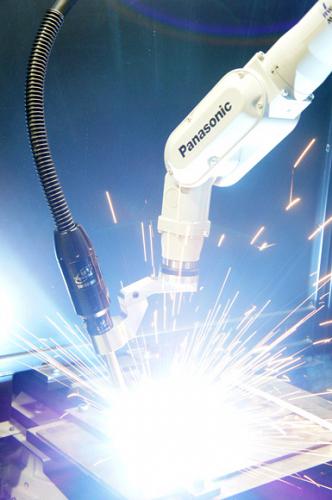
This article has been published as a web-exclusive on thefabricator.com. To read the entire story by Tregaskiss technical support specialist, Tom Whitter, please click here.
Equipment, Training, Maintenance and More: Best Practices for Successful Robotic Welding
Equipment, Training, Maintenance and More: Best Practices for Successful Robotic Welding
Manage parts and workflow
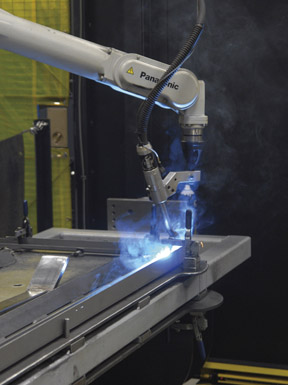
Protect against premature component failures
Don’t neglect maintenance?
• Checking for tight consumables connections.
• Confirming tool center point or TCP (discussed in more detail later).
• Checking for power cable wear and replacing as needed.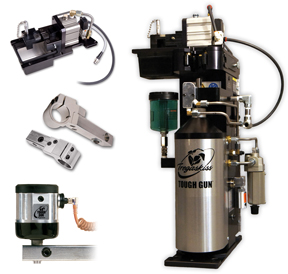
Always consider peripherals and robotic MIG gun extras
Stay on target
Find the right people
Protecting the investment
Tips for Selecting the Right Robotic MIG Gun
Tips for Selecting the Right Robotic MIG Gun
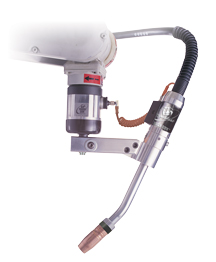
Air-cooled guns
Water-cooled guns
Hybrid air-cooled/water-cooled guns
Optional Robotic MIG Gun Features Can Improve Quality and Reduce Downtime
Optional Robotic MIG Gun Features Can Improve Quality and Reduce Downtime
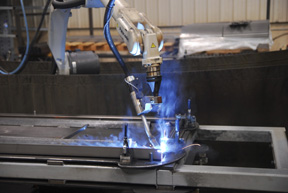
Benefits of the wire brake feature
When a wire brake offers advantages
Benefits of the air blast feature
Options that improve weld quality
Preventive Robotic MIG Gun Maintenance: the Whos, Whens, Whys and Hows
Preventive Robotic MIG Gun Maintenance: the Whos, Whens, Whys and Hows
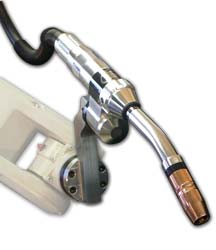
PM program basics: the whos and whens
Taking action: the whys and hows
Secure connections on a regular basis
Prevent spatter build-up
Mind the liner
Assess the welding cable and power pin
Parting thoughts on PM programs
Preventive Maintenance Isn’t Just for Welding Robots
Preventive Maintenance Isn’t Just for Welding Robots
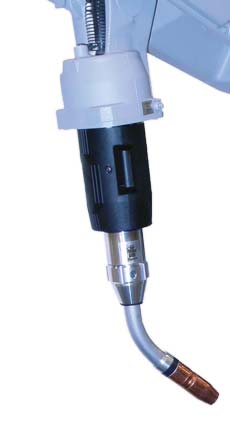
The Tasks
The Frequency and Scope
Hybrid Robotic MIG Gun Adds to Automation Benefits for Phoenix-Based Company
TOUGH GUN I.C.E. Robotic MIG Gun Adds to Automation Benefits for Phoenix-Based Company
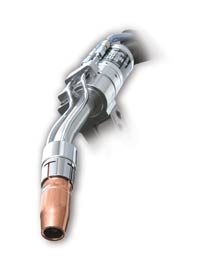
Investing in Automation
Choosing the Right Robotic MIG Gun
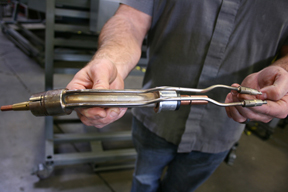
the company’s TOUGH GUN I.C.E. robotic MIG gun. The external water lines circulate coolant to the front-end consumables, helping them run cooler and last longer.Simple Ways to Protect Your Robotic MIG Gun
Simple Ways to Protect Your Robotic MIG Gun…
and Your Overall Investment in Automation
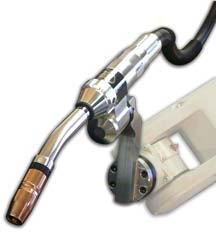
companies (regardless of their size or arc
count) should consider a preventative
maintenance program scaled to their
specific process.The Who, Why and Whens of PM
Getting Down to the Specifics
schedule a liner replacement as required. Replacing it prior to a failure prevents unplanned downtime to remedy wire feeding or quality problems later.Parting Thoughts on PM
Choosing the Right Robotic Gun for MIG Applications
Choosing the Right Robotic Gun for MIG Welding Applications

including an air-cooled model (as shown
here), can help ensure good weld quality,
and reduce equipment and maintenance cost — factors that lead to a good return on investment and greater productivity.Staying Cool with Air-Cooled Technology
Just Add Water

offer high-amperage capacity for applications
requiring prolonged periods of welding.An Option in Between

offer the durability of an air-cooled
model gun with the greater cooling
capacity of a water-cooled one,
making them an ideal fit for welding
multiple thicknesses of materials.Protecting the Assets
Selecting, Installing and Maintaining a Through-Arm Robotic MIG Gun
Selecting, Installing and Maintaining a Through-Arm Robotic MIG Gun

robotic MIG gun, it is important to
carefully select and maintain the gun,
and also to follow the manufacturer’s
instructions for installation.Selection
Installation

When installing a through-arm robotic MIG gun, allow approximately
1.5 inches of slack to prevent undue stress on the power cable
and power pin, and minimize the opportunity for damage
to either component. Maintenance
Is it Time to Automate? 5 Factors to Consider
Is it Time to Automate?
5 Five Factors to Consider
Factor #1: Plan Accordingly

and creating a detailed plan is key to gaining the many
advantages of an automated welding system.Factor #2: Evaluate Your Application
Factor #3: Assess Your Facility
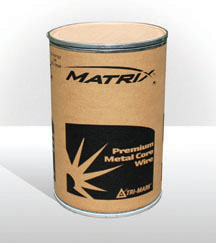
cost of purchasing larger wire packages and the
appropriate storage areas for them.Factor #4: Determine Your Available Personnel and Training
Factor #5: Justify the Expense
Final Thoughts
